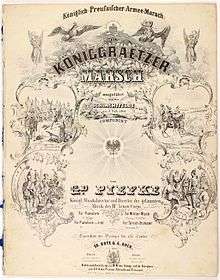Königgrätzer Marsch
| "Königgrätzer Marsch" | |
|---|---|
| March by Johann Gottfried Piefke | |
 | |
| Catalogue | AM II, 134 (AM II, 195) |
| Occasion | Commemoration of Battle of Königgrätz (1866) |
| Composed | 1866 |
The Königgrätzer Marsch (AM II, 134 (AM II, 195)), also known as Der Königgrätzer or Der Königgrätzer Marsch, is one of the most famous German military marches, composed in 1866 by Johann Gottfried Piefke in commemoration of the Battle of Königgrätz, the decisive battle of the Austro-Prussian War, in which the Kingdom of Prussia defeated the Austrian Empire. In Piefke's most successful arrangement of the Königgrätzer Marsch, another march, Der Hohenfriedberger (commemorating the Battle of Hohenfriedberg), is used as a trio. The commonly played version (AM II, 195)[1][2] is set as an infantry march, while an alternate adaptation is arranged as a cavalry galop (AM III, 228). The German military march catalogue also has the "Königgrätzer mit anderem Trio"[3] ("Königgrätzer with other Trio") (Heeresmarsch IIIB, 67), but this secondary composition is far less recognized.
History

The first draft of the march is to have been written by Piefke on the battlefield itself. The confident six-eighths meter composition follows the battle in two parts, the beginning motif signifying the indecisive combat between the first Prussian contingent and the Austrians, the second motif signifying the arrival of Prussian reinforcements. Piefke employed Der Hohenfriedberger as a trio to recall the older victories of king Frederick the Great over the Austrians in the 18th century. The victory in the Battle of Königgrätz paved the way for the supremacy of Prussia in the German Confederation and ultimately led to the establishment of the German Empire in 1871.
The Königgrätzer Marsch continues to be extremely popular and is a staple of any modern German military parade, whereas in Austria it is heard only very rarely, because the piece is associated with Austrian military failure. Like many German marches it is also used by the Chilean Army and the Russian Army. The "Königgrätzer" is the regimental march of the 2nd Battalion, The Jamaica Regiment[4] and the gallop march (with the addition of a French fanfare) of the 1st Armored Cavalry Regiment "Granaderos" of Chile.[5] It was the march of the 91st Oldenburg Infantry Regiment and the parade-march of the 1st Bavarian Infantry Regiment "König" of the Imperial German Army.
In popular culture
- The "Königgrätzer Marsch" is heard at the beginning of the massive revue parade in Leni Riefenstahl's Nuremberg Rally propaganda film, Triumph of the Will when Viktor Lutze leads SA honor guards in their march past.
- Before the Source release of Day of Defeat, the "Königgrätzer Marsch" played if the Wehrmacht faction won.
- Today it is used by the Mounted Band of the Armored Cavalry Regiment Nº1 "Granaderos", of the Chilean Army, under the name "Granaderos al Galope" as the official gallop march.
- It is currently the march of the 2nd Battalion, The Jamaica Regiment, under the name "2nd Battalion West India Regiment" (Königgrätzer Marsch)
- In Call of Duty: World at War's multiplayer mode, if the Wehrmacht faction wins the "Königgrätzer Marsch" plays. Also, in the final mission of the game's campaign mode, the song can be heard within and outside of the Reichstag while fighting a SS unit. It can also be heard in the minigame Nazi Zombies on the map Nacht Der Untoten.
- The march was featured in the film Indiana Jones and the Last Crusade, when Jones attends a Nazi book-burning ceremony to get back his father's diary.